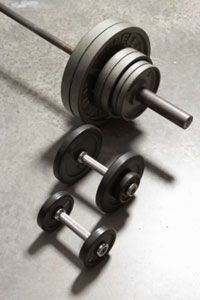Strength-training activities are not sustained over a period of time. Instead, they are activities such as weight lifting, yoga, and calisthenics, that require short-bursts of effort. Strength training burns calories, though not as many as aerobic activity. More importantly, these activities build and strengthen muscle, increasing your muscle-to-fat ratio. Remember, the more muscle mass you have, the faster your metabolism idles, burning more calories even at rest.
This article will look at the USDA strength training guidelines.
Advertisement
Benefits of Strength Training
Strength training offers many benefits. It:
- increases bone density
- strengthens joints
- improves your balance and stability
- increases your ability to do everyday tasks and with less fatigue
- improves posture
- reduces low back pain in some people
- makes your body appear slimmer, more toned, and younger
What strength training does not do, however, is make fat leave any particular spot on your body. Fat gets used up throughout the body when you burn more calories than you consume -- it's the calorie-balance story. But you can tone the muscles that lie beneath the fat stores. Then as the fat diminishes, the toned muscles are revealed and you look trimmer. Building or toning muscles occurs when your muscles work against a load (weight) or a resistance. The load can be the weight of your own body, when you do push-ups, leg lifts, abdominal crunches, and squats. Or you can use actual weights as a load, such as small hand weights, dumbbells, weight machines, resistance bands, or medicine balls. The muscle cells adapt to the extra workload in ways that first make you stronger and then, after regular strength training for some time, increase muscle size. Don't worry about getting bulky; the moderate strength training discussed here won't bulk you up.
See the next page to get started.
This information is solely for informational purposes. IT IS NOT INTENDED TO PROVIDE MEDICAL ADVICE. Neither the Editors of Consumer Guide (R), Publications International, Ltd., the author nor publisher take responsibility for any possible consequences from any treatment, procedure, exercise, dietary modification, action or application of medication which results from reading or following the information contained in this information. The publication of this information does not constitute the practice of medicine, and this information does not replace the advice of your physician or other health care provider. Before undertaking any course of treatment, the reader must seek the advice of their physician or other health care provider.
Advertisement

